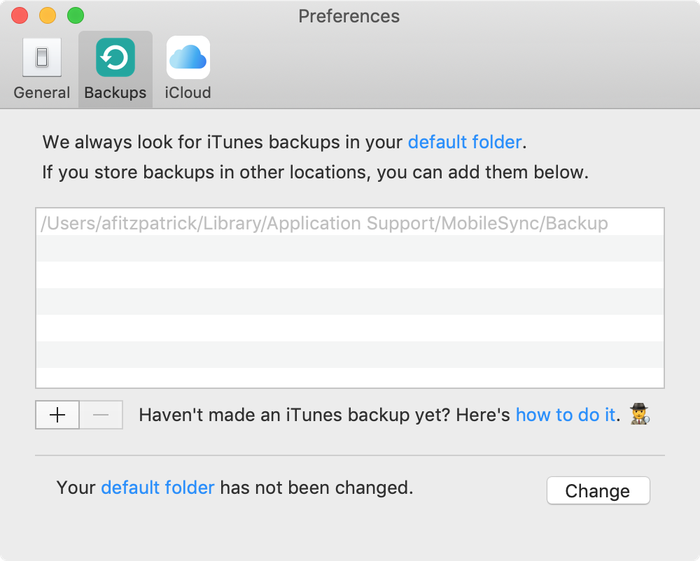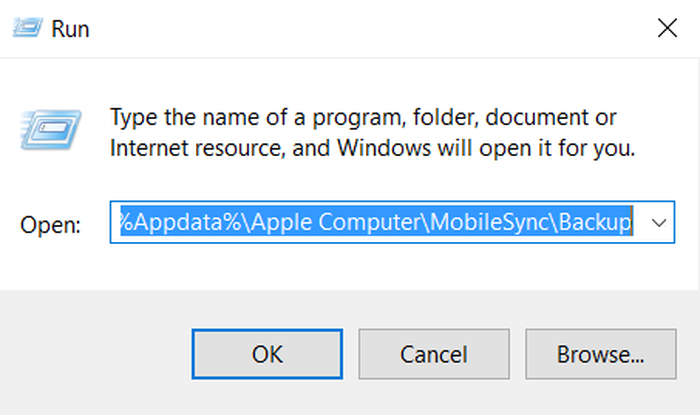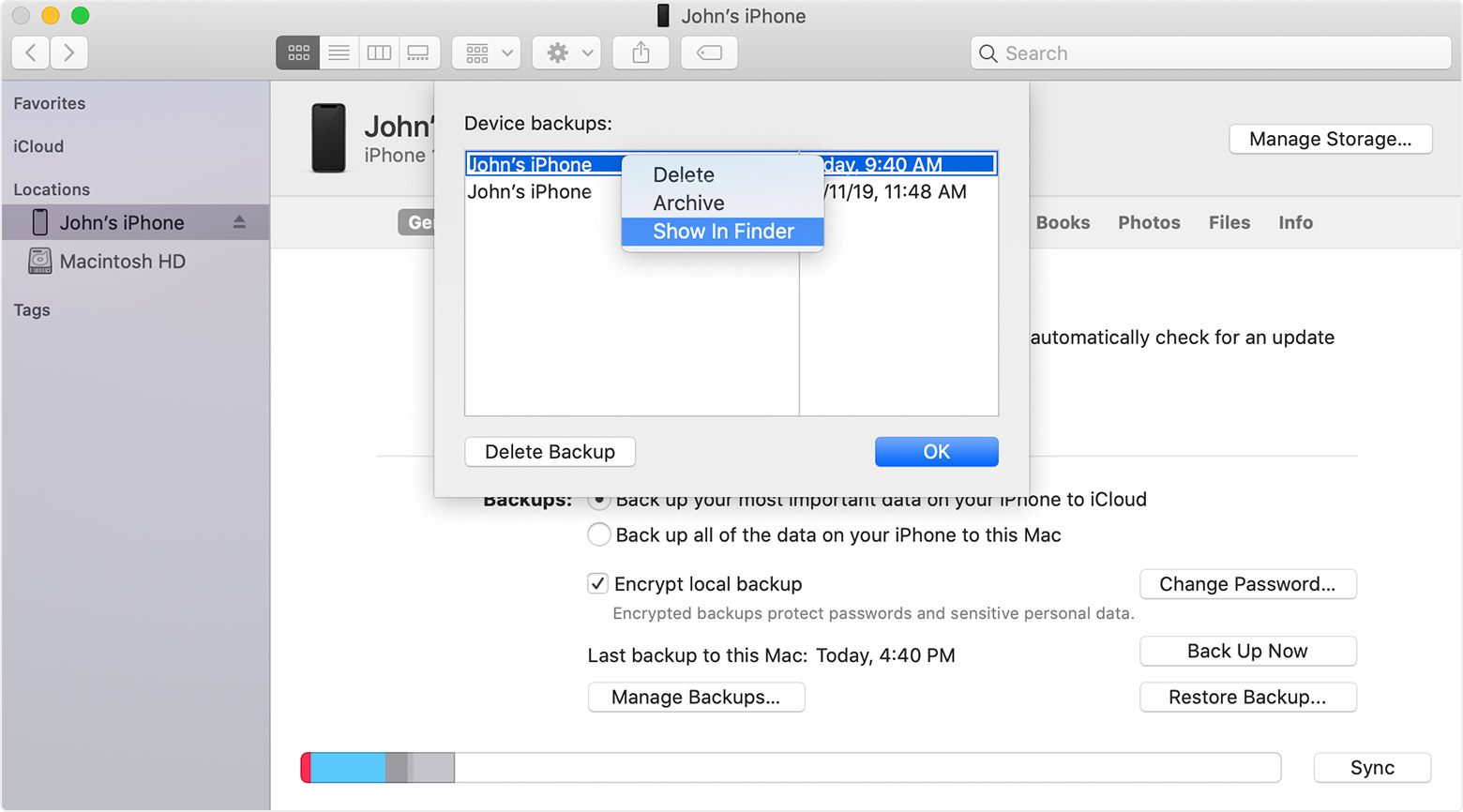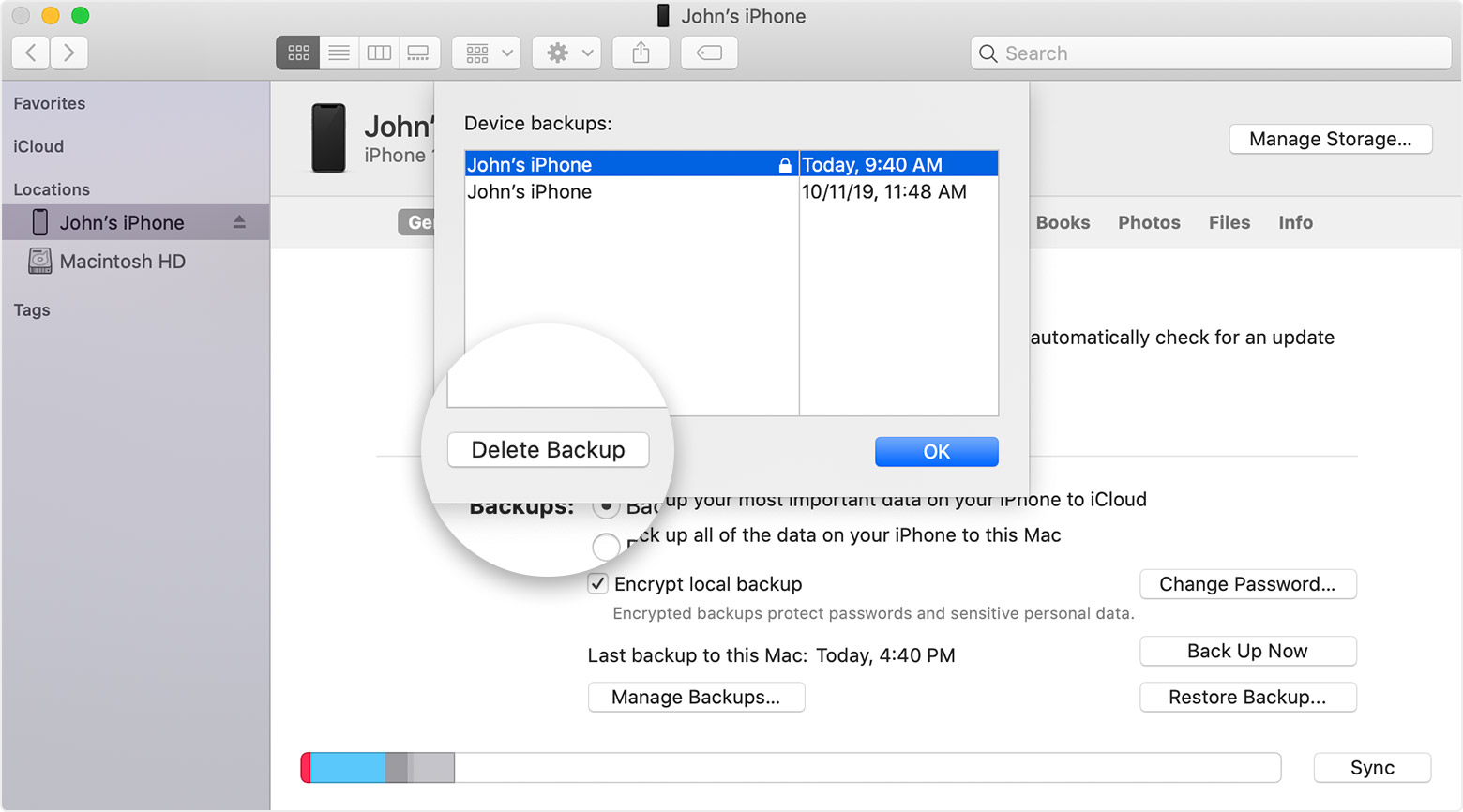- Where are iPad and iPhone backups stored on PC or Mac?
- Where is the iTunes backup folder on Windows?
- Where is the iTunes backup folder on macOS / OS X?
- How to find the iTunes backup folder automatically
- Opening the iTunes backup folder on Windows
- Finding the iTunes backup folder on macOS
- Changing the iTunes backup folder location?
- How to Change iPhone Backup Location Windows and Mac
- Part 1. Where Does iTunes Store Backup?
- 1. iTunes Backup Location On Windows
- 2. iTunes Backup Location On Mac
- Part 2. How Do I Change iTunes Backup Location Windows 10/8/7?
- Part 3. How to Change iPhone Backup Location Mac?
- Bonus Tip: Forgot iPhone Backup Password, How to Unlock It?
- Summary
- Locate backups of your iPhone, iPad, and iPod touch
- Find backups stored on your Mac or PC
- Search for the backup folder on your Mac
- Search for the backup folder on Windows 7, 8, or 10
- Delete or copy backups on your Mac or PC
- Copy backups to another location
- Delete backups
- Locate and manage backups stored in iCloud
Where are iPad and iPhone backups stored on PC or Mac?
If you accidentally deleted some information from an iOS device and hope to recover it, an iTunes backup can be a great help.
iTunes backups happen automatically, each time you connect your iPad or iPhone with iTunes (if you didn’t turn on the iCloud Backup option), or manually, when you right-click the device in iTunes and choose ‘’Back Up’’. They are saved on your computer and contain important data, such as contacts, text messages, calendar, notes, call history and app data.
So where are iPhone or iPad backups stored? It depends on which operating system your computer is using, although the default backup location is the same between iOS versions.
Where is the iTunes backup folder on Windows?
iTunes backups are stored in %APPDATA%\Apple Computer\MobileSync on Windows.
On Windows 10, 8, 7 or Vista, this’ll be a path like \Users\[USERNAME]\AppData\Roaming\Apple Computer\MobileSync\Backup .
With Windows XP that’d be similar to \Documents and Settings\[USERNAME]\Application Data\Apple Computer\MobileSync\Backup .
The Microsoft Store version of iTunes is a little different: it stores its backups under %HOMEPATH%\Apple\MobileSync . That’ll be a path like \Users\[USERNAME]\Apple\MobileSync\Backup .
Where is the iTunes backup folder on macOS / OS X?
iTunes backups are stored in
/Library/Application Support/MobileSync on macOS.
That folder is typically at /Users/[USERNAME]/Library/Application Support/MobileSync/Backup .
In macOS 10.15, Finder creates iPhone backups, instead of iTunes. However, these backups are stored in the same location.
How to find the iTunes backup folder automatically
iPhone Backup Extractor automatically finds the iTunes backup folder for you, and can open it with a click. This functionality is in the free version, so this won’t cost a thing.
- Download and install iPhone Backup Extractor
- Open the Preferences window from the app’s pull-down menu
- Select the Backups tab.
- Where the window says «We always look for backups in your default folder», click the «default folder» link. Easy!

Opening the iTunes backup folder on Windows
Open the default Backup location in Explorer using the Windows Run command. Press ⊞ Win + R and the Run window should appear. Enter %APPDATA%\Apple Computer\MobileSync and press ⏎ Enter .
For the Microsoft Store version of iTunes, you could do this: Press ⊞ Win + R and the Run window should appear. Enter %HOMEPATH%\Apple\MobileSync and press ⏎ Enter .
Here’s what this looks like on Windows 10:

The Explorer window that opens will show a folder named «Backup». This contains any iTunes backups which are already present on the computer.
Finding the iTunes backup folder on macOS
The default backup location can be shown in Finder using Spotlight. Pressing ⌘ Cmd + and type
/Library/Application Support/MobileSync before pressing ⏎ Enter .
The Finder window that opens will show a folder named «Backup». This contains any iTunes backups which are already present on the computer.
Changing the iTunes backup folder location?
If you’d like to change the folder that iTunes backups up to by default, we have a handy guide in our support centre.
How to Change iPhone Backup Location Windows and Mac
Where does iTunes store backups? The default directory for iTunes is the system partition. This can pose a sluggish performance problem as the iOS backup size is always increasing will take a large space on your system drive.
At this point, you can either save your iTunes files to an external hard drive or change iTunes backup location to another drive partition. Herein is a guide how to change iTunes backup location Windows 10/8/7 and Mac.
Part 1. Where Does iTunes Store Backup?
1. iTunes Backup Location On Windows
By default, iTunes backup location is in the following directory:
- Windows 10: C:\Users\USER\AppData\Roaming\Apple Computer\MobileSync\Backup
- Windows 7/8 or Vista:Users(username)/AppData/Roaming/Apple Computer/MobileSync/Backup
2. iTunes Backup Location On Mac
All you need to do is to go to the Finder. It is easy to find iTunes backup location on Mac. Just press the «Option» button, select «Go» and then select «Library». The default path is:
Part 2. How Do I Change iTunes Backup Location Windows 10/8/7?
After knowing where iTunes backup is stored, you can follow these steps to change backup location iTunes.
First, create a folder on another drive partition like D: drive. Rename it to a suitable name like «New iTunes Backup.» You can as well create the new backup folder on an external hard drive, flash drive or thumb drive.
Open the iTunes MobileSync directory by typing «%APPDATA%\Apple Computer\Mobile Sync» or C:\Users\[USERNAME]\Apple\MobileSync if you are using the Windows Store version of iTunes.
Rename the «Backup» folder to «Old Backup» or wherever you want to change iPhone backup location.
Enter the following text in the command prompt box. After pressing Enter, you will get a success message from a command prompt that a new junction has been created.
For iTunes desktop version: cmd /c mklink /J “%APPDATA%\Apple Computer\MobileSync\Backup” “D:\New iTunes Backup”
For iTunes Windows Store version: cmd /c mklink /J “C:\Users\[USERNAME]\Apple\MobileSync\Backup” “D:\New iTunes Backup”
Connect your iPhone to the PC and try an iTunes backup using either a cable or a WiFi connection. The backup files will now be stored in «D:\New_Backup».
Part 3. How to Change iPhone Backup Location Mac?
Changing iPhone backup location on Mac is a little different. You have to use symbolic links (or symlinks) which lets you create a dummy folder that points to another location.
Type the following code in the Spotlight (that you can bring up by clicking Cmd+Space):
Now, right-click the Backup folder and copy the Backup folder to the location you want iTunes change backup location.
Go back to the MobileSync folder and rename the original backup folder to say BackupOld.
Open System Preference > Security & Privacy.
Choose the Privacy tab and click ‘Click the lock to make changes’ option at the bottom left of the screen. Click Full Disk Access on the left-hand side of the screen and then choose +.
Click Utilities > Terminal > Open to add Terminal to the list of apps with full control on your computer.
Launch the terminal. Now, enter the following code in one line.
ln -s /Volumes/Files/Backup/
You need to properly check that the symlink is working properly by opening the following link in the Finder:
Bonus Tip: Forgot iPhone Backup Password, How to Unlock It?
Sometimes doing a backup can be impossible if you forgot iPhone backup password. If this is the case, you can download Tenorshare 4uKey — iTunes Backup on your PC to perform iTunes backup password recovery.


Run the program after installing and select «Retrieve iTunes backup password» from the main interface.
Double-clicking the backup you want to unlock.
Select an attack type. iPhone Backup Unlocker decrypts iTunes password using three methods: brute force, brute force with mask attack
Click on «Start» begins the decryption process. After several minutes, your password will be listed in the File Opening Password Box.
Summary
This is all about where does iTunes store backups and how to change itunes backup location Windows 10 and Mac. And if you happen to forgot iPhone backup password, Tenorshare 4uKey — iTunes Backup will help you recover it. Share this article if it’s helpful.


Updated on 2020-11-19 / Update for iTunes Backup
Locate backups of your iPhone, iPad, and iPod touch
Find a list of your iOS or iPadOS backups on your Mac, PC, and iOS or iPadOS device. Learn how to delete backups, copy them, and more.
Find backups stored on Mac or PC
Delete or copy backups stored on Mac or PC
Find and manage backups stored in iCloud
Find backups stored on your Mac or PC
To avoid ruining any of your backup files, here’s what you should know:
- The Finder and iTunes save backups to a Backup folder. The location of the Backup folder varies by operating system. Though you can copy the Backup folder, you should never move it to a different folder, external drive, or network drive.
- Don’t edit, relocate, rename, or extract content from your backup files, because these actions might ruin the files. For example, to restore from a relocated backup file, you need to move it back or the file won’t work. Backups serve as a safe copy of your entire device. So while you might be able to view or access a backup file’s contents, the contents usually aren’t stored in a format that you can read.
Search for the backup folder on your Mac
To find a list of your backups:
- Click the magnifier icon in the menu bar.
- Type or copy and paste this:
/Library/Application Support/MobileSync/Backup/
To find a specific backup:
- On a Mac with macOS Catalina 10.15 or later, open the Finder. On a Mac with macOS Mojave 10.14 or earlier, or on a PC, open iTunes. Click your device.
- In the Finder, under the General tab, click Manage Backups to see a list of your backups. From here, you can right-click on the backup that you want, then choose Show in Finder, or you can select Delete or Archive. In iTunes, choose Preferences, then click Devices. From here, you can right-click on the backup that you want, then choose Show in Finder, or you can select Delete or Archive.
- Click OK when you’re finished.
Search for the backup folder on Windows 7, 8, or 10
- Find the Search bar:
- In Windows 7, click Start.
- In Windows 8, click the magnifying glass in the upper-right corner.
- In Windows 10, click the Search bar next to the Start button.
- In the Search bar, enter %appdata%. If you don’t see your backups, enter %USERPROFILE%.
- Press Return.
- Double-click these folders: «Apple» or «Apple Computer» > MobileSync > Backup.
Delete or copy backups on your Mac or PC
Don’t edit, relocate, rename, or extract content from your backup files, because these actions might ruin the files. Use the following sections to make copies of your backups or delete backups that you no longer need.
Copy backups to another location
If you need copies of your backups, you can find the Backup folder and copy the entire folder (not just part of it) to another place, like an external drive or network-storage location.
When you use Time Machine, it automatically copies your Backup folder when you back up the Home folder on your Mac.
Delete backups
- On a Mac with macOS Catalina 10.15 or later, open the Finder. On a Mac with macOS Mojave 10.14 or earlier, or on a PC, open iTunes. Click your device.
- In the Finder, under the General tab, click Manage Backups to see a list of your backups. From here, you can right-click on the backup that you want, then select Delete or Archive. In iTunes, choose Preferences, then click Devices. From here, you can right-click on the backup that you want, then choose Delete or Archive. Click OK when you’re finished.
- Click Delete Backup, then confirm.
Locate and manage backups stored in iCloud
If you use iCloud Backup, you won’t find a list of your backups on iCloud.com. Here’s how to find your iCloud backups on your iOS or iPadOS device, Mac, or PC.
On your iPhone, iPad, or iPod touch:
- Using iOS 11 or later and iPadOS, go to Settings > [your name] > iCloud > Manage Storage > Backups.
- Using iOS 10.3, go to Settings > [your name] > iCloud. Tap the graph that shows your iCloud usage, then tap Manage Storage.
Tap a backup to see more details about it, choose which information to back up, or delete the backup.
You can choose which content to back up only from the Settings menu of the device that stores that content. For example, while you can view your iPad backup from your iPhone, you can choose which iPad content to back up only from the Settings menu of your iPad.
On a Mac with macOS Catalina 10.15 or later:
- Choose Apple () menu > System Preferences.
- Click Apple ID.
- Click iCloud.
- Click Manage.
- Select Backups.
On a Mac with macOS Mojave 10.14 or earlier:
- Choose Apple () menu > System Preferences.
- Click iCloud.
- Click Manage.
- Select Backups.
- Open iCloud for Windows
- Click Storage.
- Select Backup.










